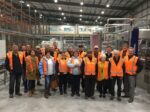Massey University announced as partner of the New Zealand National Fieldays Society
In the picture:Massey University’s Vice Chancellor, Professor Jane Thomas, signing an agreement with New Zealand National Fieldays Society CEO Peter Nation. New Zealand National Fieldays Society, owner of the iconic Fieldays event in June, has a new partner in the form of Massey University. The university and Society signed the three-year initial term agreement earlier this month, ahead of the first Society board meeting to be held offsite since incorporation. Fieldays celebrates its 50th anniversary this year during the 13-16 June event at Mystery Creek near Hamilton. Nick Dromgool, GM Commercial for the Society, believes Massey University’s strong focus on the agricultural and health sectors makes it a strong partner for the Society and the Fieldays event. “Fieldays has been bringing rural and urban audiences together for 50 years, and we are very pleased about this connection with Massey University. Fieldays is a truly New Zealand event and we feel Massey’s ethos of being an accessible university through its many campuses and its distance learning is an excellent fit.” Massey University is well-known for agri-related study and research, and also has top equine, vet and food programmes. It has a strong focus on health and has many other unique schools within its campuses. The university was recently recognised in the 2018 QS World University Rankings, placing 22nd in the world’s universities for agriculture and forestry, and 23rd for veterinary science. College of Sciences Pro Vice-Chancellor Professor Ray Geor says Massey is excited about connecting with the Society at a partnership level. “We are a strong supporter of Fieldays and have always had a large presence at the event. This year we are very pleased to be able to really cement that relationship,” he says. “Fieldays is a premier event, recognised in world agribusiness,” adds Professor Geor. “It’s an excellent fit […]








